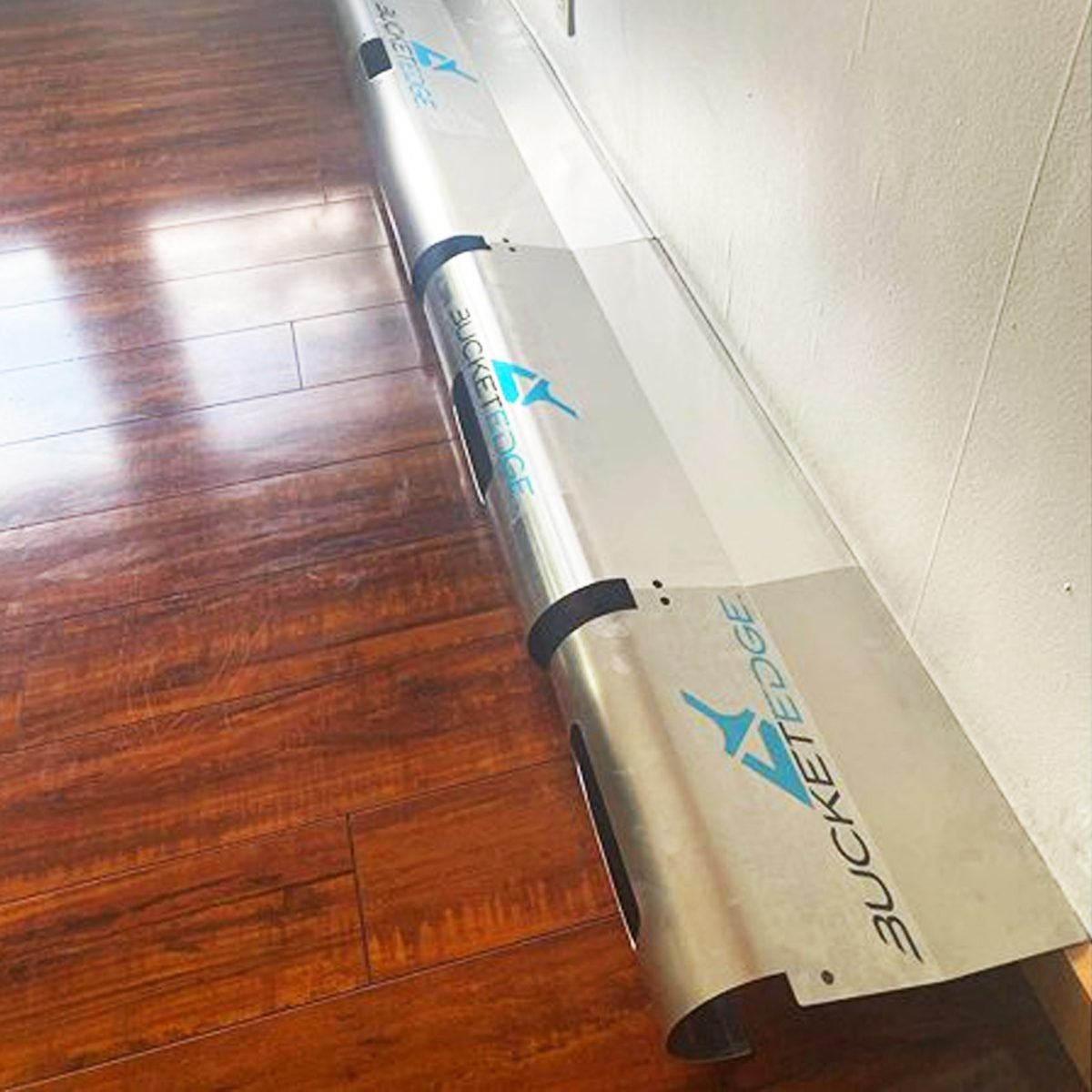Homeowners and contractors rejoice! The Bucket Edge is here to give you the peace of mind you need while painting walls and ceilings.
Our editors and experts handpick every product we feature. We may earn a commission from your purchases.Learn more.


Homeowners and contractors rejoice! The Bucket Edge is here to give you the peace of mind you need while painting walls and ceilings.
Our editors and experts handpick every product we feature. We may earn a commission from your purchases.Learn more.
One of the most nerve-wracking parts of interior painting is ensuring nothing drips onto your trim or the floor. Sure, you can put masking or painter’s tape anywhere you don’t want paint, but that sucks up so much time you could spend painting. Enter the Bucket Edge, a heavy-duty painting guard that leaves trim and other surfaces untouched while painting.
On This Page
The Bucket Edge is a piece of heavy-duty aluminum that sits over your trim or other surfaces that you don’t want to get paint on. Unlike masking tape, it takes seconds—not minutes—to set up, and there’s zero risk of paint seeping through.
You can also use this painting tool to cut and mark straight lines, remove bubbles from wallpaper and scrape ceilings. That’s not all: it replaces your dustpan and is even useable as a funnel in a pinch.
 VIA MERCHANT
VIA MERCHANT
The Bucket Edge eliminates the need for taping trim, baseboard, floors and plastic prep work.
The Bucket Edge works well for those on a budget since it cuts down on the number of painting tools. It also eliminates the need for painter’s tape, which is better for the environment. Made from very strong, thick gauge aluminum, the tool is easy to clean by rinsing or wiping with a damp cloth. Need a longer unit? Simply lock it together with other Bucket Edges for longer walls.
Spend less time on prep work when you don’t have to tape trim, baseboards and floors. As a bonus, it doubles as a giant dustpan and spray shield, encouraging sharp paint lines that look professional. Weighing in at a mere 2.7 pounds for the 40-inch version, the Bucket Edge is lightweight enough for anyone to use.
Simply place the Bucket Edge over the area you’re trying to protect and start painting. It comes in three sizes (12-, 20-, and 40-inches), so there’s no job too big or too small. The three sizes nest together for easy storage.
To use it as a dustpan, turn it upside down and sweep all the debris onto the flat surface. Pick it up and use the funneled ends to ensure every last bit goes into your trash bag—not all over your floors.
Five-star reviewer Jimmy has been a house painter since the 1990s and writes that this is one of the most useful tools in his arsenal. “I absolutely hated painting before I found this tool. Why? I hate taping off a room and it cuts into my labor costs…These are well put together, and the edges are not flimsy. I have two more sets on the way!”
“The Bucket Edge tools are awesome! I bought them after we purchased a new home,” reviewer Jennifer Mccabe explains. “They worked great to paint the entire home. No doubt they saved us tons of time not having to tape off nearly as much and we didn’t need to tarp off floors. My husband loves the Bucket Edge and will continue to use them in his construction and remodeling business.”
“This tool has been amazing,” customer Justin remarks. “I will never paint without them and definitely recommend this product. Saves a tremendous amount of time as well as money spent on tape. It has been useful on every job so far which is impressive.”
The Bucket Edge is a step up from regular masking tape, making it an indispensable tool for DIYers and professional painters alike. Whether it’s touching up trim or supporting a full renovation, painting with this tool makes painting virtually slob-proof.
There are three different sizes available at Amazon and Walmart. The 12-inch is great for small projects, like painting furniture or window sashes. The 40-inch is ideal for large jobs. And if you’re a professional—or have a lot of DIY painting projects in your future—it’s worth investing in the Bucket Edge three-piece set that includes 12-, 20- and 40-inch models. If you ask us, it’s worth the price to never worry about paint dripping on our trim.
 VIA MERCHANT
VIA MERCHANT
The Bucket Edge eliminates the need for taping trim, baseboard, floors and plastic prep work.
When it comes to the best painting tools, edgers and masking tape (or painter’s tape) are two of the most crucial. Not only do they prevent shaky edges, but they eliminate drips and splotches. 3M ScotchBlue Painter’s Tape Applicator is handy to have on hand for those who prefer using tape for window edging or other spaces that rely on precise application.
Professional painters usually follow a certain order when painting a room. They paint the trim first, then the ceiling, then the walls. That’s because it’s easier (and faster) to tape off the trim than to tape off the walls. And you certainly don’t want to tape them both off.
When painting the trim, you don’t have to be neat. Just concentrate on getting a smooth finish on the wood. Don’t worry if the door and trim paint gets slopped onto the walls. You’ll cover it later when painting walls.
One of our best tips for cutting in paint is to finish up by feathering or thinning the edge. Without reloading the brush, drag the tips of the bristles lightly over the outside edge to spread the paint in a thin layer and get rid of any ridges or paint buildup. This painting hack helps ensure that your cut-in paint won’t show as a stripe after you roll paint onto the walls.